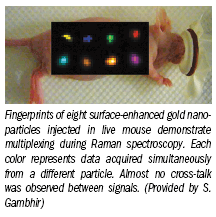Raman spectroscopy sets new multiplexing standard
Imagine an exam that combines into a single scan the diagnostic imaging power of 10 PET studies, each measuring an essential dimension of cancer's aggressiveness, metastatic potential, and susceptibility to radio- and chemotherapy.
Imagine an exam that combines into a single scan the diagnostic imaging power of 10 PET studies, each measuring an essential dimension of cancer's aggressiveness, metastatic potential, and susceptibility to radio- and chemotherapy.
That day may arrive soon thanks to the inventive work of Dr. Sanjiv Sam Gambhir's molecular imaging laboratory at Stanford University. Its creative use of in vivo Raman spectroscopy promises to add “multiplexing” to the everyday language of imaging practice.
Raman spectroscopy, a sophisticated quantum physics technique that produces huge bursts of molecular excitation, earned its discoverer, Sir Chandrasekhara Venkata Raman, a Nobel prize for physics in 1930. Commonly used in chemistry, it is also applied in medicine to monitor anesthesia and respiratory gas mixtures during surgery. Its application in in vivo medical imaging is new, however, Gambhir said in an interview.
Raman spectroscopy uses a dual-component probe to target relevant physiology and produce a recordable signal. FDG, for example, accumulates in cancer cells, where it is phosphorolated and metabolized. Fluorine-18 radioisotope produces a positron signal that a PET scanner detects and localizes.

In Raman imaging, the localizing mechanisms are similar to those used in nuclear medicine, but the signaling mechanism is unique. A specific array of molecules is attached to gold nanoparticles. When the nanoparticle is excited with light, most of the photons elastically scatter at the same output frequencies as the input frequencies. With Raman scattering, however, some light is inelastically scattered, Gambhir said. The gold nanoparticles and their Raman layers amplify the inelastic scattering, so far more photons than normal are inelastically scattered.
As a result, the return signal is sharp and easily detectible. The signal amplification is huge, as is the signal-to-noise ratio, because background tissue produces little noise. Tissues where the Raman particles migrated because of their engineered targeting mechanism are amplified by the inelastically scattered light to produce an image.
In terms of multiplexing, Raman spectroscopy puts all medical imaging modalities preceding it to shame. With advanced energy windowing, SPECT imaging has simultaneously mapped the distribution of two radiopharmaceutical probes, such as thallium-201 and technetium-99m sestamibi. But the Stanford group's latest Proceedings of the National Academy of Sciences paper describes the simultaneous display of 10 types of targeted Raman particles simultaneously. And there is no technical reason why Raman spectroscopy will not eventually multiplex many times that number, Gambhir said.
The disadvantages of Raman spectroscopy include poor tissue penetration, similar to the problems encountered during infrared optical imaging. Targeted Raman particles involve a complex of gold atoms producing a much larger molecule than most radiopharmaceuticals, Gambhir said. Penetrating the blood-brain barrier and the interiors of larger tumors may be difficult.
For its initial experiments, the Stanford group adapted a Raman microscope for small-animal imaging. Each Raman particle can be aimed at a specific cell surface receptor, protein, enzyme, or other organic chemical. The return signal can be tuned to a specific radiofrequency to allow multiplexing.
The Stanford group favors a point-by-point raster data acquisition technique capable of submillimeter spatial resolution. The temporal resolution is about 30 minutes for whole-body mouse imaging. With additional improvements, the procedure will be performed in about 90 seconds, Gambhir said.
The Stanford group is with working with the FDA to rapidly move Raman particle imaging into the clinical arena. With the help of a National Cancer Institute grant, they are building a Raman endoscope for colorectal applications.
Gambhir and colleagues envision spraying the wall of the colon with targeted Raman particles. These would latch onto cancer cells and could help expose hard-to-detect flat polyps.
The endoscopic approach potentially addresses the inherent tissue penetration problem. Toxicity is less of a concern for the FDA when the agent is released and quickly ejected from the bowel, Gambhir said.
Multiplexing would help boost diagnostic accuracy, Gambhir said. Instead of targeting only carcinoembryonic antigen on the cancer cell surfaces, the application can simultaneously target epidermal growth factor receptor on the cells.
“If you then aim your gold nanoparticles at third and fourth targets, the detection of the disease becomes increasingly specific,” Gambhir said.
GE HealthCare Debuts AI-Powered Cardiac CT Device at ACC Conference
April 1st 2025Featuring enhanced low-dose image quality with motion-free images, the Revolution Vibe CT system reportedly facilitates improved diagnostic clarity for patients with conditions ranging from in-stent restenosis to atrial fibrillation.
The Reading Room Podcast: Current Perspectives on the Updated Appropriate Use Criteria for Brain PET
March 18th 2025In a new podcast, Satoshi Minoshima, M.D., Ph.D., and James Williams, Ph.D., share their insights on the recently updated appropriate use criteria for amyloid PET and tau PET in patients with mild cognitive impairment.